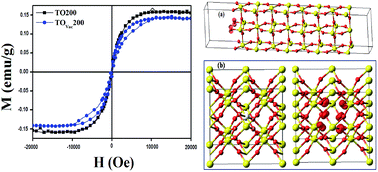Room temperature ferromagnetism in SnO2 nanoparticles: an experimental and density functional study†
Abstract
Room temperature ferromagnetism is observed in pristine SnO2 nanoparticles prepared via sol–gel method. Microstructural studies with XRD and Raman reveal the coexistence of SnO and SnO2 phases in vacuum annealed SnO2. Electron paramagnetic resonance (EPR) results confirm the presence of paramagnetic trapped hole in lattice oxygen atoms and superoxide radical species in air and vacuum annealed SnO2. It is observed that growth conditions have significant influence on the magnetism of the nanoparticle. Air and vacuum annealed SnO2 display clear ferromagnetic behavior at room temperature. However, the saturation magnetization decreases in vacuum annealed SnO2. We have compared the experimental results with ab initio density functional calculations and observed that the Sn vacancies are the main reason of magnetism in SnO2. The pattern of theoretical formation energy values shows that it is easier to form Sn vacancies in SnO2 under O rich limit (similar to air annealing). This is in conformity with the experimentally determined higher saturation magnetization values in air annealed SnO2. The spin polarization of lattice oxygen atoms by the presence of Sn vacancy gives rise to magnetism.


 Please wait while we load your content...
Please wait while we load your content...